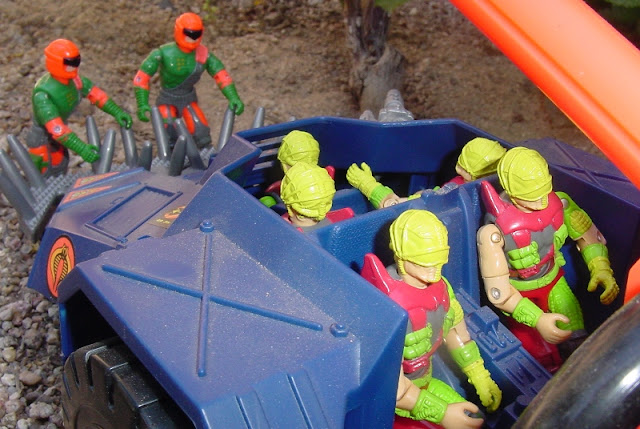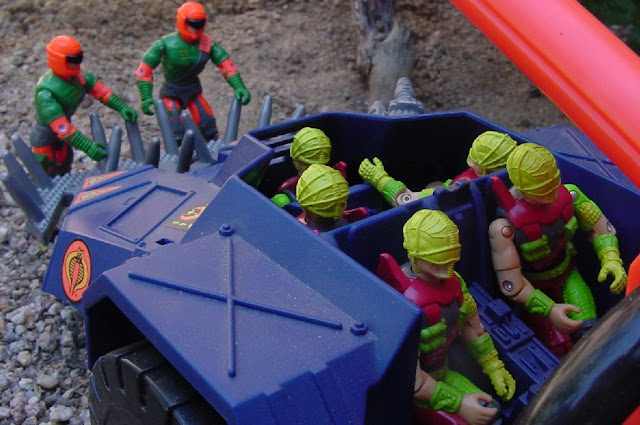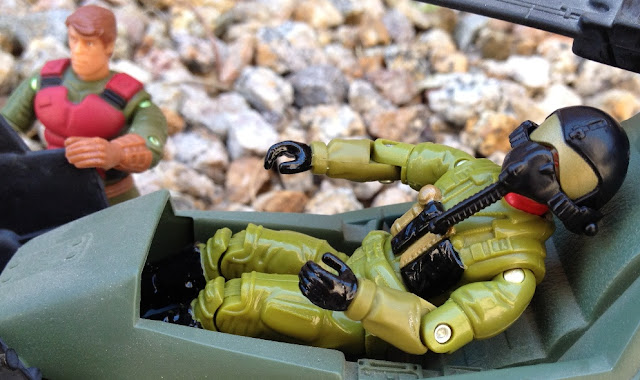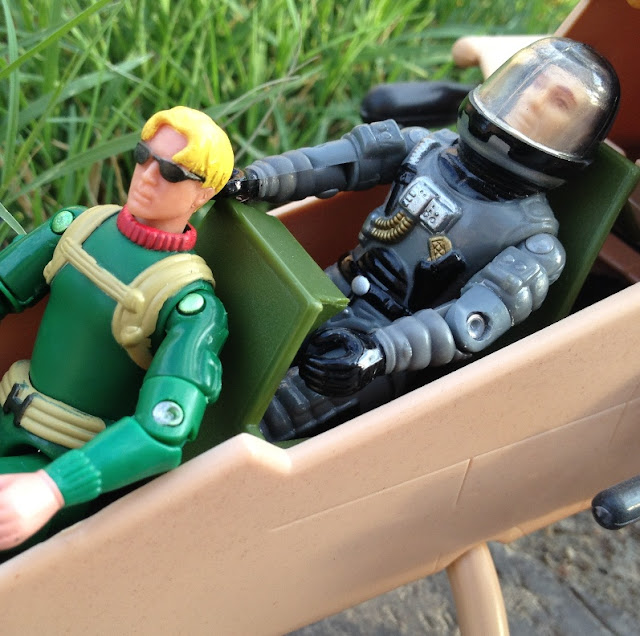When I looked at the beat up box of the Detonator, I was not overly impressed. Even as a discounted $10.00 price tag, I could not bring myself to buy it. The large foam missiles and bright colors didn't do anything for me. So, the vehicle stayed behind and was not added to my collection. In early 1999, I acquired my first Nitro Viper from Hasbro Canada. This rekindled an interest in the Detonator. But, by that time, finding Detonators online wasn't easy and the cost to ship one was more than I was willing to pay. Finally, in 2000, I purchased a lot of figures and vehicles. I mainly bought it for the huge quantity of 1992 though 1994 army builders in the lot. But, one of the other items included was my first Detonator.
As soon as I looked at the opened toy, my perception of the Detonator completely changed. The vehicle itself was done in a decently dark blue color and featured many silver highlights. Without the missiles loaded, the vehicle was actually somewhat menacing. But, the real play value was the massive cockpit that could hold a full 5 seated figures. I have always liked vehicles with large control areas. It gave a large number of figures something to do as well as added play value to the vehicle. I could easily display the 1993 Cobra Commander at the head of convoy in the elevated chairs. It was a perfect way to hold army builders, especially the neon versions from 1993 and 1994. But, above all, it was a greatly detailed toy that had the type of control space I always wanted since I had first acquired a Maggot.
Unfortunately, the back of the Detonator does not live up to the front. Hasbro installed a massive air cannon in the main body to launch the foam missiles. With the missiles removed, this can pose as a heavy artillery cannon. But, the bright red color takes away from the vehicle as a whole. The vehicle, though, is adorned with a multitude of foot pegs to hold the massive crew it would take to manually lift another missile from the storage brackets on the sides of the vehicles onto the launcher. It's an impractical solution. But, that can be said of most of Cobra's vehicles. The front of the vehicle features a small cannon to provide some additional firepower. In case any Joe had designs of jumping onto the front of the vehicle, though, the Detonator also comes equipped with an array of vicious spikes to keep away pesky infantry.
Many collectors have been able, though, to take the body of the Detonator and customize it into something much more useful. There are customs out there of the Detonator mounted with an ASP, multiple anti-aircraft weapons and even more realistic missile launchers. Some were even modified to be more of a troop carrier than even the Parasite. The Detonator has great customizing potential and is cheap enough that many collectors won't feel guilty about cutting one up to make something even better than Hasbro offered.
If you read the final two years or so of the Marvel G.I. Joe comic, the role of the standard Cobra armored vehicle was taken by the Detonator. Previously, this role had been the sole domain of the classic Hiss Tank for many years. But, Hasbro's influence in the comic was felt and the Detonator became the de facto Cobra armor in the mid 1990's. That exposure went largely unnoticed by me at the time since I was reading the comic, but not following the toys. Only upon re-reading did I realize how pervasive the Detonator came to be in the comic's final years. But, it did give this mold some exposure and establishes it as an important piece of the Cobra armory.
The Detonator was released in 1993 in North America. Around 2001, though, the mold showed up in India. There, Funskool released a Detonator in colors rather similar to the American version. (But, the differences are enough to make the Funskool version worth acquiring, too.) This Indian version was imported in fairly large quantities for a few months. So, there are a decent amount of them available in American collections. The mold disappeared after that and is unlikely to ever appear again.
By and large, collectors don't care about the Detonator. As such, even mint and complete versions are very cheap. The problem is that the vehicle is large and heavy. So, you might buy one for under $20, but then pay another $20 just to get it shipped to you. For my money, though, the vehicle is worth it. Tons of play features, good size and a solid base color all add up to something that any collector can appreciate. The customizing potential is also another great reason to look into the vehicle. At this point, I wish I had a couple of additional Detonators in my collection, just for the display value alone. Perhaps, that will one day come to pass. But, for now, I'm glad I have at least on Detonator as it has become a staple of my collection.































